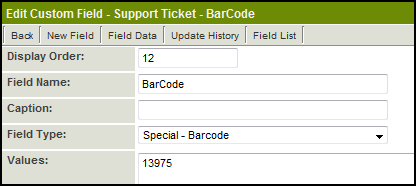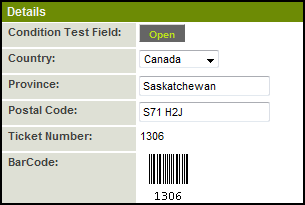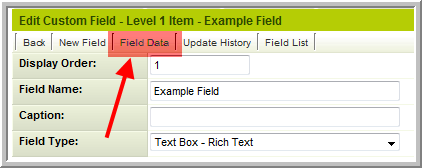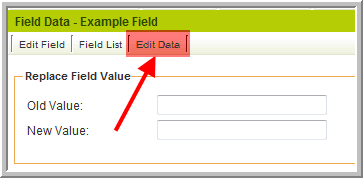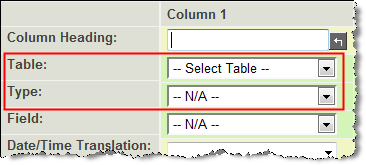Upgrades by Category
Contents
Security Enhancements
| Feature | Upgrade Date | Password Expiration You can now set a system-wide password expiration number of days. Each user will be forced to change their password once that number of days has passed. |
April 2009 | Password History You can set the number of previous passwords (to a maximum of 32) that the system will remember for each user. When changing their password, users will not be permitted to re-use a previous password until the specified number of unique passwords has been used. |
April 2009 | Instance Lock-Down
|
May 2009 | Remove User Access
|
May 2009 | Terminate User Session
|
May 2009 | Enable Logout
|
May 2010 | Custom Password Policy
|
May 2010 | Local Administrator E-mail Alert
|
May 2010 | Primary Authentication Controller
|
October 2010 | Reporting on User Type and Access Type
|
October 2010 | Hierarchical Password Policy
A different password policy can be defined for each company which will automatically apply to all sub-companies in the hierarchy, unless they have defined their own password policy. |
May 2011 | Persistent Login
|
May 2011 | Email Restriction
|
May 2011 | Backup Server Access
|
May 2011 | SSencrypt Command
|
May 2011 | URL Parameter Encryption
|
May 2011 |
|---|
UTA Enhancements
| Feature | Upgrade Date | Standard Field Visibility Control
|
April 2009 | Level 1: Tabs for Contact and Account Lists
|
April 2009 | Level 1: UTA Contact and Account Filters
|
April 2009 | Level 1: Contact Restrictions
|
April 2009 | Level 2: Multiple Contact List
If you enable the Use Multiple Contact List checkbox on the Settings > Application Configuration screen you will be able to associate and control contact associations in a similar manner to Level 1 contacts. |
April 2009 | Level 2: Multiple Account List
If you enable the Use Multiple Account List checkbox on the Settings > Application Configuration screen you will be able to associate and control account associations in a similar manner to Level 1 contacts. |
April 2009 | Level 2: Role Filtering
You can restrict the selection of contacts that can be associated with Level 2 items by role. Previously you could only restrict by specified named contacts. An additional lookup text area has been added the bottom of the Level 2 Types Settings page to specify the roles. |
April 2009 | Disabling Specific Transaction Types by Template
|
April 2009 | Level 3 Template Formulas
You can now associate template formulas with Level 3 items in the same manner as Level 2 and Level 1 items. |
April 2009 | Submitted URL Redirect
|
May 2009 | Suppress New Level 2 or Level 3 Buttons
|
May 2009 | Batch Update Owner Field
|
May 2009 | Cross-UTA Transactions
|
May 2009 | Level 1 Submit Button Script
|
July 2009 | Level 2 and Level 3 Submitted URL
|
July 2009 | Level 2 Type Tab Label
|
July 2009 | Skills Matching Template
|
July 2009 | Advanced Logic to Suppress Contact Hyperlinks
|
July 2009 | Record Lock
|
October 2009 | Level 1, Level 2 & Level 3 Formulas
|
October 2009 | Advanced Logic to Suppress Public Notes
|
October 2009 | Internal Branch Filter
|
October 2009 | Level 3 Default Type Setting
|
October 2009 | Batch Update
|
May 2010 | Archive Level 1 Activities
|
May 2010 | Filter Person Based on Customer
|
May 2010 | Level 2: Disable Default Assign
|
May 2010 | Focus Highlight
|
May 2010 | Record Unlock
|
May 2010 | UTA Data Exchange Automatic Unpack
|
May 2010 | Role-Based List Views
|
October 2010 | Level 2 & 3 List View Colour
|
October 2010 | Level 3 Activity List Batch Update | October 2010 | Master Schedule Template
|
October 2010 | Level 2 Assign By Role
|
October 2010 | Level 2 Side Scrolling
|
October 2010 | Transaction Batch Update
|
October 2010 | Data Exchange
The Data Exchange has 3 new features:
|
October 2010 | Level 1 Status Indicator
|
May 2011 | Default Contact Role
|
May 2011 | Level 1 Template Branch Restriction
|
May 2011 | Quick Entry
|
May 2011 | List View Heading
|
May 2011 | "Is Empty" Search
|
May 2011 | Lock on Type
|
May 2011 | Creation Roles
|
May 2011 | Available Statuses
|
May 2011 | Recurring Activities
|
May 2011 | Level 2 Contact Calendar Status
|
May 2011 | Assign By Role Expansion
|
May 2011 | Invoice Status Batch Update
|
May 2011 | Void Invoice
|
May 2011 | UTA Role Custom Fields
|
May 2011 | Group Contact Assignment
|
May 2011 | Multiple Contact/Company List
|
May 2011 | Aggregation UTA
|
May 2011 | Data Exchange
|
May 2011 | UTA Connection List View
|
May 2011 | Template Pages
|
May 2011 |
|---|
Calendars
| Feature | Upgrade Date | Recurring Calendar Events
|
May 2009 |
|---|
Contacts/Accounts
| Feature | Upgrade Date | Contact and Account Standard Field Terminology
|
July 2009 | MS Outlook Contact Synchronization
|
July 2009 | Geocoding
|
October 2009 | Unique Contact Identifier
|
May 2010 | Primary Contact
|
May 2010 | Accounts List View
|
May 2010 | E-mail From Address
|
May 2010 |
|---|
Custom Fields
| Feature | Upgrade Date | Auto Save Custom Field
|
May 2009 | Bar Code Custom Field
In the above example 13975 is the Custom Field ID of the "Ticket Number" field, which would display on the record as: |
May 2009 | Custom Field Tabs
In the above example there are 3 tabs named "Additional Details", "Company Information" and "Contract Details" Navigation between the tabs can be accomplished by either clicking on the Next or Previous buttons, or by clicking on the name of the tab you wish to access. |
May 2009 | MS Word Merge Enhancement
|
May 2009 | Field ID Variable
|
July 2009 | Custom Field Number Format
|
October 2009 | Single File Field Online Editing
|
October 2009 | Single/Multiple File Field Upload Workflow
|
October 2009 | Edit Data
When prompted enter the opportunityid (Level 1) or eventid (Levels 2 & 3) for the relevant record and a pop-up window will appear allowing you to directly edit the data in the selected field for that record. |
October 2009 | Custom Field Type: Special - XML Data
|
May 2010 | Custom Field Type: Special - Spreadsheet
|
May 2010 | New Custom Field Type: Select One - User Group
|
May 2010 | New Custom Field Type: Lookup - ICD Code
|
May 2010 | Web Page View Field: SSattach
<!--@ssattach(insert;@static pdf.value@;n)-->
<!--@ssattach(after;@Cvfile.value@)-->
<!--@ssattach(after;@Cvfiles.files@)--> |
May 2010 | Web Page View Settings
|
May 2010 | Single File Custom Field Settings
|
May 2010 | Multiple Files Custom Field Settings
|
May 2010 | ICD Code Lookup Button
|
October 2010 | Onload Function
|
October 2010 | Post to External Server
|
October 2010 | Standard Field Edit Condition
A conditional statement can be entered to control whether standard fields appear as editable or read only. The conditions can be based on role, status, or other criteria. This feature applies to company, contact and Universal Tracking Application standard fields. |
May 2011 | Custom Field Language Display
The captions displayed on custom fields can be configured for multiple languages. When viewing a record the personal language setting for each user will determine which language is displayed to them. |
May 2011 | New Custom Field Type: Special - Hand Drawing
This field type stores freehand drawings done either with a mouse or touch sensitive screen. The background image can be defined, as well as the colours to be used and patterns/images that can be "stamped" onto the image. |
May 2011 | Enable Camera Snapshot
The "Display Only - Image" custom field has a setting that enables a web cam attached to the computer to be used as the source of the image to be stored in this field type. |
May 2011 | Document Console
When using the Multiple Files custom field you can enable the document console. This allows you to easily preview and print the documents. |
May 2011 |
|---|
Document Management
| Feature | Upgrade Date | MS Word Merge Custom Field
|
April 2009 | Allow Merging of PDF Documents
|
April 2009 | Multiple File Field: Display Additional File Attributes for PDF Documents
|
April 2009 | Single File Field: Display Additional File Attributes for PDF Documents
|
April 2009 |
|---|
Personal Settings
| Feature | Upgrade Date | Time Format
|
May 2009 |
|---|
Reports
| Feature | Upgrade Date | Report Variables
Example: To display the exported report for the report with ID 12345 @ReportProperty(12345,exportdata)@ These 2 variables can be used in a Web Page View or Read Only - System Variables custom field, or be included in the body of a Workflow message.
|
May 2010 | Report Builder - Table Selection
|
May 2010 | Show Total
|
May 2010 | Caching and Record Limit
|
May 2010 | Record Lock
|
May 2010 | Export Button
|
October 2010 |
|---|
SmartFolders
| Feature | Upgrade Date | Inclusion of Folders in Search
|
May 2009 |
|---|
Variables / Variable Processor
| Feature | Upgrade Date | Report Record Count Variable
Example: To generate the number of records (equivalent to the number of rows in the report) for report with ID 12345 @ReportProperty(12345,recordcount)@ This can be used in a Web Page View or as a Read Only - System Variable to display a record count, as part of Submit Logic, or included in the title of a Portal shortcut to indicate how many records are at a given status (for example). |
October 2009 | Assign Level 1 Customer
|
October 2009 | User/Company Association List
|
October 2009 |
|---|
Web Forms
| Feature | Upgrade Date | Web Form Status
|
May 2009 | Convert Web Form to PDF
|
May 2009 |
|---|
Workflows
| Feature | Upgrade Date | Level 2 Creation
|
May 2009 | HTML E-mail Format
|
May 2009 | Recurring Workflows
|
May 2010 | People Association Workflow Task Type
|
May 2010 | Level 1 Date Trigger
|
May 2010 | UTA Role Assignment Tasks
|
May 2010 | Transaction Workflows
|
May 2010 | Workflow E-mails
|
May 2010 | Select User for Next Task
|
October 2010 |
|---|
Miscellaneous
| Feature | Upgrade Date | Custom Defined Holidays
Example: ssvar_holidays=',2009-01-01,2009-02-16,2009-04-10,2009-05-18,2009-07-01,2009-08-03, 2009-09-07,2009-10-12,2009-12-25,2009-12-26,2009-12-28,2010-01-01,2010-04-02,2010-05-24, 2010-07-01,2010-08-02,2010-09-06,2010-10-11,2010-12-27,2010-12-28,'; |
May 2010 | System Date & Time
|
May 2010 | Chat | May 2010 | Variable Processor Enhancements
@fieldname.value@ or using field ID: @#fieldid.value#@
@fieldname.numoffiles@ or using field ID: @#fieldid.numoffiles#@ |
May 2010 | Advanced Logic
|
May 2010 | Company and Contact Role-Based List View
|
October 2010 | List Calendars by Company
|
October 2010 | Autoloader Support for XML Files
|
October 2010 | Email Attach from Smart Folder
|
October 2010 | HCAI Status | October 2010 | SMTP Settings
|
October 2010 | Advanced Logic
|
October 2010 |
|---|



